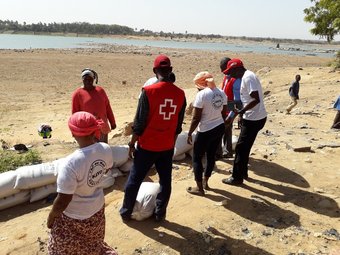Categories
Mali
Key facts
Hazards covered by anticipation
Drought | Floods
People reached by anticipation
Start Network 2016: 54,842
Anticipation partners in country
Mali Red Cross | FAO | IFRC | Netherlands Red Cross | Danish Red Cross
Inform Risk Index (2022)
Hazard and exposure: 7.3
Vulnerability: 7.1
Lack of coping capacity: 6.6
Total: 7.0 (very high)
Rank: 11
Photo: IFRC
Country profile
Mali is a low-income, landlocked country with a hot, desert climate - but with high variability between its dry and wet periods. The eight largest country by land area in Africa, it is regularly confronted with disasters including floods, droughts, epidemics, epizootics, strong winds and locust invasions. Since 2012, conflict has led to further instability.
Hazards and conflict are the main drivers of humanitarian crises in Mali. Of these, floods and droughts are the primary hazards, occurring on an annual basis and posing a significant risk, especially in the southern region.
Mali is among the most at-risk countries globally for drought, and this hazard - along with extreme heat - affects the most people in the country, while adding further pressure on unevenly distributed water resources. Droughts often have long-lasting impacts and may lead to severe food insecurity, loss of livestock and water scarcity.
Flooding occurs mostly along the Niger and Senegal rivers and their tributaries, especially between September and November. Both riverine and urban floods cause a high number of fatalities in Mali, as well as considerable damage to houses, transport systems, and health and education infrastructure. For example, in 2018 flooding affected 137,000 people, leading to fatalities and the loss of livestock and crops, while also destroying houses and wells.
Agriculture and livestock account for 45% of the country’s gross domestic product and 80% of employment, making them the most important sectors for people’s livelihoods. They are also the sectors most affected by natural hazards and conflict, with particularly adverse effects on people’s food security and nutrition.
Many natural hazards are expected to increase in frequency and severity because of climate change. This will result in even greater impacts, for example from drought, floods, strong winds and bush fires, while increased variability in seasonal rainfall patterns will lead to higher uncertainty for farmers and agricultural systems.
Projects
Forecast-based Financing in Mali
Since 2017 Mali Red Cross has worked with support from Belgium RC, Netherlands RC, Danish RC, 510, IFRC, and the Climate Centre to develop an EAP for floods. A second hazard is now being identified and an EAP will eventually be developed.
In 2016 Mali START Network provided funds for Catholic Relief Services and Action Against Hunger to create or strengthen community early warning systems and reduce impacts in anticipation of flooding along the Niger river (alert 117).


